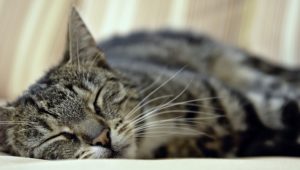
Is your cat shedding a lot? Here is some info on cat shedding and grooming tips!
Like all pets, cats come with a set of care needs, and grooming is high on the list. It is not uncommon to begin to see cat fur or hairs scattered around the house on clothing, furniture, and floors at some point. Even so, you can greatly help your cat and your home by understanding cat shedding and dealing with it properly.
Cat Shedding Season
When exactly do cats shed? For many breeds, cats shed year-round. However, they also have summer and winter coats that they shed in the fall and spring, respectively. This type of shedding is normal for many healthy felines.
What Breeds Shed?
In general, you might observe that cats breeds from colder climates and ones with longer hair are more likely to be shedders. Of course, short-haired cats can shed, too. Breeds that do shed include the following: American Bobtail, American Curl, British Longhair, Chartreux, Coupair, Cymric, Himalayan, Kurilian Bobtail, Main Coon, Nebelung, Oriental Longhair, Ragamuffin, Ragdoll, and Siberian.
What Kind of Coat Does Your Cat Have?
To take the best approach for grooming your pet, understand what kind of coat it has. First, how many coats does your cat have? Some have one, two, or three, based on how they kept warm in the wild. From shortest to longest, the three types of cat hair are down, awn, and guard hairs.
Second, does your cat have hair or fur? All cats have hair, but that hair is fur when you cannot separate the coat to find your cat’s skin underneath. Fur is very dense.
How to Deal with Cat Shedding
There are two main steps for dealing with cat shedding: grooming and bathing. Regular brushing, about twice a week, will keep the hairs from flying around the house and reduce the chance of hairballs. One could use either a brush for long or short-haired cats or a grooming glove.
As for bathing, your cat can benefit from this once a month, once every other month, or whenever necessary. At the minimum, you can wipe your cat with a damp towel to help remove hairs and keep the coat clean.
Giving your cat a summer cut is also an idea. This option can help reduce shedding, hairballs, and matting, but it is best to consult your vet beforehand. Everhart Veterinary Medicine is here to help in Maryland!
Potential Underlying Health Issues
Excessive shedding could be a sign of an underlying medical issue. It could be allergies, stress, poor nutrition, hyperthyroidism, or a hormonal disorder. Visit Everhart Veterinary Medicine for your cat’s health!
Trust the Care of Your Pet to the Professionals at Everhart Veterinary Medicine!
At Everhart Veterinary Medicine, our veterinary professionals strive to provide your pet with the very best of veterinary care. We believe that the best care for your pet should be provided by experienced, compassionate, and knowledgeable veterinary professionals. With two Maryland locations in both Baltimore and Pasadena, we are always ready to welcome your pet as a new patient! Give us a call today at 410-355-3131 or 410-793-7670! For more information, as well as updates on veterinary news and topics, visit us on Facebook, Twitter, or LinkedIn!
